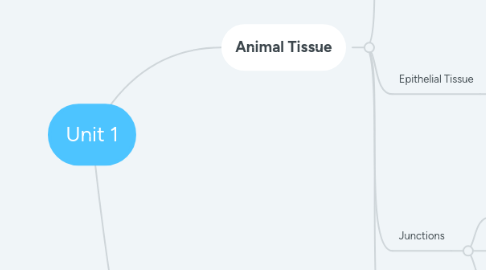
1. Animal Tissue
1.1. Types of Tissue
1.1.1. Loose C.T.
1.1.2. Dense C.T.
1.1.3. Adipose Tissue: Store energy for later use, not very rich in blood vessels, used for insulation and padding
1.1.4. Muscle tissue
1.1.4.1. Skeletal: Found in voluntary muscles and tendons, contract, striated, sparse nuclei, used for movement
1.1.4.2. Smooth: Found in organs, slow but steady use means it won't get exhausted easily, not striated, loose ends, nuclei, not striated
1.1.4.3. Cardiac: Heart only, striated, sparse nuclei, connected via intercalated discs, used to contract together as a unit
1.2. Epithelial Tissue
1.2.1. Simple Squamous: Flat layer of square cells, found in blood vessels and tubules
1.2.2. Stratified Squamous: Layers of flat square cells, found in skin/mouth/vagina (areas where abrasion can occur), protection
1.2.3. Cuboidal: Cube shaped, secrete/absorb, found in glands like thyroid, may have microvilli
1.2.4. Columnar: Long column, secrete/absorb, found in digestive tract, may have microvilli
1.3. Junctions
1.3.1. Tight junctions: Let some molecules in?
1.3.2. Gap Junctions: Leaky
1.3.3. Anchor Junctions: Let big molecules in?
1.4. Molecule types
1.4.1. Adipose Cells: Steroids like testosterone, lipophilic
1.4.2. More I can't think of: One had mostly lipophilic, I think another was very simple/not much info on it
1.4.3. Peptide: Mostly hydrophilic, some lipophilic.
2. Endocrine System
2.1. Homeostasis - keeping the internal environment balanced, the primary goal
2.1.1. Can be done through the excretion of hormones from glands
2.1.1.1. Hydrophilic vs Lipophilic
2.1.1.1.1. Hydrophilic molecules bind to outside receptors and travel easily through bloodstream, cause a cascade of events, and don't need to be attached to receptor for long
